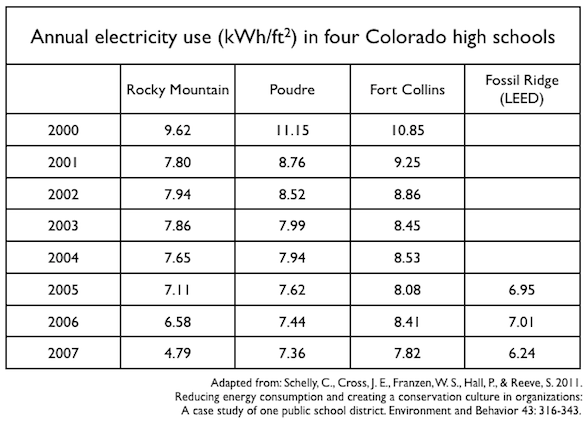
Which factors are most significant in reducing energy use: personal attitudes toward the environment, social norms around conservation, or availability of key infrastructures and technologies?
One study into this question was a 2011 paper comparing electricity use at four Colorado high schools (“Reducing Energy Consumption and Creating a Conservation Culture in Organizations: A Case Study of One Public School District”).
The paper highlights the fact that energy conservation efforts can achieve dramatic results — especially in a community-based context like a school. Moreover, as EnergyStar.gov reports (“For K-12 School Districts”), U.S. K-12 schools spend more on annual energy bills than on purchases of textbooks and computers.
Chelsea Schelly, Jennifer Cross, and coauthors examined 2000-07 data on four high schools in the Poudre School District of Fort Collins, Colorado. One of the four, Rocky Mountain High School had achieved electricity savings far greater than the others, prompting the question: “What did Rocky do that was different than the other schools, and can we replicate this across the district?”
From the case study:
Rocky was able to reduce its energy consumption by 50% because it is in a district that made a commitment to energy conservation and sustainability, supported leaders in all organizational levels, and provided policies and incentives in support of schools making a commitment to sustainability. In this context, Rocky made unprecedented change; it reduced its electricity consumption to levels below a newly built and certified LEED school. …
In this school, perceived efficacy, behavioral expectations, and organizational culture all motivated behavioral change, but no participants described changing their attitudes. Respondents indicated that even without a sense of environmental concern and without engaging in environmentally responsible behaviors at home, they participated in energy conservation and other efforts (such as recycling) within the organizational setting. This suggests that setting new standards is more important than changing environmental values.
Furthermore, different motivational factors were important for different participants. Charismatic leaders were motivated by their personal environmental values, whereas students and staff members were motivated by feelings of efficacy. Participants at all organizational levels responded to communication, particularly comparative feedback, and the district and the school made concerted efforts to communicate both expectations and successes.
[Update: This post led to an email discussion with colleagues about the authors’ use of the term “efficacy,” which is similar to what I often call a “sense of agency.” Additional excerpt below.]
Efficacy and beliefs. Students and staff at both schools discussed the importance of feeling like their efforts make a difference or perceived efficacy. At Rocky, sense of efficacy was related to having the opportunity for responsibility and decision making. … One student said,
‘I felt like that at first when I heard all this global warming and stuff; you think about it and it’s such a big problem, there’s nothing I can do. Once you start doing things and seeing the difference it makes, I think that’s just so important.’
H/t to Karen Ehrhardt-Martinez of the Garrison Institute’s Climate, Mind and Behavior Program, who discussed these findings at the 2012 Ecodistrict Summit.

